

Signal Transduction. Signal transduction (also known as cell signaling) is the transmission of molecular signals from a cell's exterior to its interior.
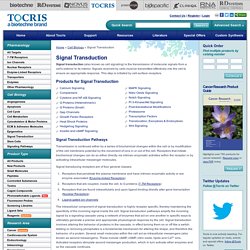
Signals received by cells must be transmitted effectively into the cell to ensure an appropriate response. This step is initiated by cell-surface receptors. Products for Signal Transduction Signal Transduction Pathways Transmission is continued either by a series of biochemical changes within the cell or by modification of the cell membrane potential by the movement of ions in or out of the cell. Signal transducing receptors are of four general classes: Receptors that penetrate the plasma membrane and have intrinsic enzymatic activity or are enzyme associated (Enzyme-linked Receptors)Receptors that are coupled, inside the cell, to G proteins (7-TM Receptors)Receptors that are found intracellularly and upon ligand binding directly alter gene transcription (Nuclear Receptors)Ligand-gated ion channels Physiology and Disease. Signal transduction. Simplified representation of major signal transduction pathways in mammals.
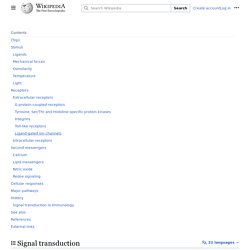
Domino cascade is a daily life analogy of signal transduction cascade Stimuli[edit] 3D Medical animation still showing signal transduction. The basis for signal transduction is the transformation of a certain stimulus into a biochemical signal. The nature of such stimuli can vary widely, ranging from extracellular cues, such as the presence of EGF, to intracellular events, such as the DNA damage resulting from replicative telomere attrition.[7] Traditionally, signals that reach the central nervous system are classified as senses.
Ligands[edit] Not all classifications of signaling molecules take into account the molecular nature of each class member. Some receptors such as HER2 are capable of ligand-independent activation when overexpressed or mutated. Mechanical forces[edit] The prevalence of basement membranes in the tissues of Eumetazoans means that most cell types require attachment to survive. Osmolarity[edit] Structural Biochemistry/Proteins/Protein in Signal Transduction - Wikibooks, open books for an open world. Introduction to Signal-Transduction Pathways[edit] Signal transduction is the chain of events that occurs when a cell converts a message to ultimately a physiological response.
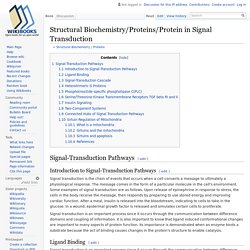
The message comes in the form of a particular molecule in the cell’s environment. Passive and Facilitated Diffusion - BioWiki. Botulinum Toxin Type A Mode of Action. Cell Signalling Biology. Cell Communication. Red Blood Cells Photo Credit: By Redbloodcells.jpg: hematologist derivative work: patient-doc (Redbloodcells.jpg), via Wikimedia Commons Purpose To develop an understanding of cell-to-cell communication.
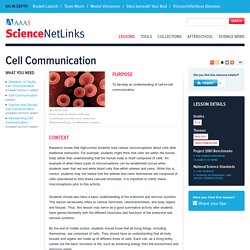
Context Research shows that high-school students hold various misconceptions about cells after traditional instruction. For example, students might think that cells are within the human body rather than understanding that the human body is itself composed of cells. Students should also have a basic understanding of the endocrine and nervous systems. By the end of middle school, students should know that all living things, including themselves, are composed of cells. Hedgehog signaling pathway: an overview. Contents: Introduction The Hedgehog gene was identified in genetic screens aimed to provide an understanding of body segmentation in Drosophila (Nusslein-Volhard et al., 1980).
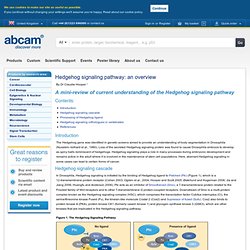
Loss of the secreted Hedgehog signaling protein was found to cause Drosophila embryos to develop as spiny balls reminiscent of hedgehogs. Hedgehog signaling plays a role in many processes during embryonic development and remains active in the adult where it is involved in the maintenance of stem cell populations. Here, aberrant Hedgehog signaling in some cases can lead to certain forms of cancer. Hedgehog signaling cascade In Drosophila, Hedgehog signaling is initiated by the binding of Hedgehog ligand to Patched (Ptc) (Figure 1), which is a 12-transmembrane protein receptor (Cohen 2003; Ogden et al., 2004; Hooper and Scott 2005; Østerlund and Kogerman 2006; Jia and Jiang 2006; Huangfu and Anderson 2006).
Biochemistry and Cell Signaling Pathway of the Mc1r Gene. Vasopressin (ADH) Vasopressin is a neurohypophysial hormone found in most mammals. It is a nonapeptide with a cyclical structure. Vasopressin is codified by a gene contained into the 20th human chromosome. When relevant for the function Primary structure The amino acid sequence is characterized by a sulphide bridge between two cysteines. Secondary structure Tertiary structure Quaternary structure Protein Aminoacids Percentage The Protein Aminoacids Percentage gives useful information on the local environment and the metabolic status of the cell (starvation, lack of essential AA, hypoxia) Protein Aminoacids Percentage (Width 700 px) The ADH is synthesized into the sopraoptic and paraventricular nucleus (SON and PVN ) by specialized nerve cells that reside into the hypothalamus and from which slope, through pituitary peduncle, hypothalamic nerve cells until reaching neurohypophisis from which ADH is released as a consequence of a specific stimulus.
The ADH synthesis is formed by six main passages: Cancer Biology – Inside Cancer: A Multimedia Guide to Cancer. Cell Signals. Home DNA Learning Center Preparing students and families to thrive in the gene age 3-D Animation Library Cell Signals Journey inside a cell as you follow proteins and learn about cellular interactions.
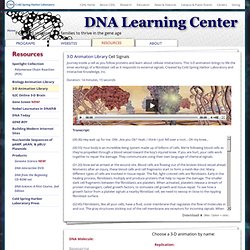
This 3-D animation brings to life the inner workings of a fibroblast cell as it responds to external signals. Reactome. Membrane-Bound Receptors, G Proteins, and Ca2+ Channels. Johnson Explorations - Cell-Cell Interactions. Bonnie Bassler: How bacteria "talk". Interactive Concepts in Biochemistry - Interactive Animations.
Interactive Cell Signaling Pathways. BD Biosciences - Pathway List. Cell Signaling Technology.